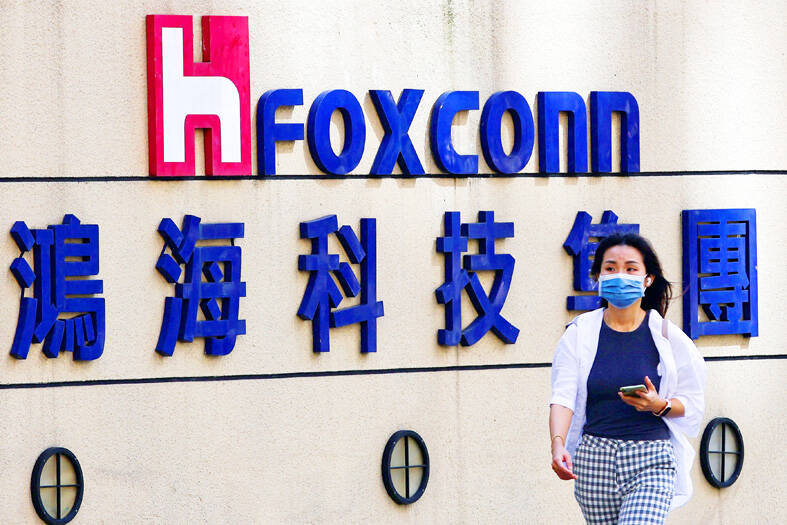Foxconn Technology Group (富士康科技集團) has ended a months-long “closed loop” system at the world’s biggest iPhone factory in central China, citing Beijing’s nationwide loosening of its “zero COVID” regulations.
Earlier this week, the Chinese government rolled back most mass testing and lockdown requirements to hasten a return to normal life, significantly relaxing three years of disease prevention restrictions that have tanked its economy and wearied its population.
The Foxconn facility in Zhengzhou City was in effective lockdown for 56 days, with workers only allowed to travel between their dormitories and the factory floor on shuttle buses after cases were discovered in October.

Photo: Ann Wang, Reuters
In the middle of last month, violent protests by new recruits erupted over salaries and conditions, with hundreds marching, and some clashing with riot police and health workers.
The company on Thursday said it was ending the closed loop system.
“Given the ... further lifting of China’s epidemic control measures, the company requires employees to present a 48-hour negative test result in order to return to work,” a notice posted on Thursday on the WeChat account of Foxconn’s main campus in Zhengzhou, Henan Province, said.
The company added that its shuttle buses had resumed service and urged employees who had not been taking part in the closed loop to return to work “as soon as possible.”
Other WeChat accounts of agencies hiring for Foxconn also announced that the “closed loop is lifted.”
Foxconn, known as Hon Hai Precision Industry Co (鴻海精密) in Taiwan, is the world’s biggest contract electronics manufacturer and assembles gadgets for many international brands.
Most of its factories are in China, with its biggest in Zhengzhou — which has been dubbed “iPhone city.”
Lockdowns were imposed in the city last month as part of Beijing’s “zero COVID” policy after a spike in infections.
The prolonged factory disruption and protests heavily impacted Foxconn’s hiring practices and rocked supply chain stability, to which Beijing attaches high importance.
A letter sent by Foxconn founder Terry Gou (郭台銘) warning the Chinese leadership about the damage to supply chains from the “zero COVID” policy helped government advisers argue for an end to the policy, the Wall Street Journal reported on Thursday, citing people familiar with the matter.
Foxconn’s reported revenue last month fell 11.4 percent year-on-year and 29 percent from October.
It earlier said it was revising down its outlook for the fourth quarter.
Some analysts have predicted sales could drop as much as 20 percent.

United Microelectronics Corp (UMC, 聯電) expects its addressable market to grow by a low single-digit percentage this year, lower than the overall foundry industry’s 15 percent expansion and the global semiconductor industry’s 10 percent growth, the contract chipmaker said yesterday after reporting the worst profit in four-and-a-half years in the fourth quarter of last year. Growth would be fueled by demand for artificial intelligence (AI) servers, a moderate recovery in consumer electronics and an increase in semiconductor content, UMC said. “UMC’s goal is to outgrow our addressable market while maintaining our structural profitability,” UMC copresident Jason Wang (王石) told an online earnings

Gudeng Precision Industrial Co (家登精密), the sole extreme ultraviolet (EUV) pod supplier to Taiwan Semiconductor Manufacturing Co (TSMC, 台積電), is aiming to expand revenue to NT$10 billion (US$304.8 million) this year, as it expects the artificial intelligence (AI) boom to drive demand for wafer delivery pods and pods used in advanced packaging technology. That suggests the firm’s revenue could grow as much as 53 percent this year, after it posted a 28.91 percent increase to NT$6.55 billion last year, exceeding its 20 percent growth target. “We usually set an aggressive target internally to drive further growth. This year, our target is to

The TAIEX ended the Year of the Dragon yesterday up about 30 percent, led by contract chipmaker Taiwan Semiconductor Manufacturing Co (TSMC, 台積電). The benchmark index closed up 225.40 points, or 0.97 percent, at 23,525.41 on the last trading session of the Year of the Dragon before the Lunar New Year holiday ushers in the Year of the Snake. During the Year of the Dragon, the TAIEX rose 5,429.34 points, the highest ever, while the 30 percent increase in the year was the second-highest behind only a 30.84 percent gain in the Year of the Rat from Jan. 25, 2020, to Feb.

Cryptocurrencies gave a lukewarm reception to US President Donald Trump’s first policy moves on digital assets, notching small gains after he commissioned a report on regulation and a crypto reserve. Bitcoin has been broadly steady since Trump took office on Monday and was trading at about US$105,000 yesterday as some of the euphoria around a hoped-for revolution in cryptocurrency regulation ebbed. Smaller cryptocurrency ether has likewise had a fairly steady week, although was up 5 percent in the Asia day to US$3,420. Bitcoin had been one of the most spectacular “Trump trades” in financial markets, gaining 50 percent to break above US$100,000 and